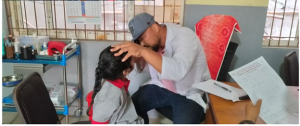Join the Leading Global Eye Health Alliance.
Membership-
Choose an alternate language here

The school eye screening program involved trained optometrists and ophthalmic assistants who conducted vision tests, identified refractive errors, and referred students for further eye examinations where necessary. Out of the total screened students, 6,175 were male and 5,462 were female. The screening revealed that a total of 1,260 students (10.8%) were suffering from refractive errors, indicating the need for corrective glasses. Among them, 701 were male students (11.3% of males screened) and 559 were female students (10.2% of females screened). Additionally, 304 students (2.6%) were found to have other ocular diseases such as allergic conjunctivitis, squint, and suspected of amblyopia. Interestingly, the prevalence of these non-refractive conditions was similar in both genders, affecting 2.6% of both male and female students.
The gender-wise evidence from the program highlights the importance of gender-sensitive approaches in planning and delivering school eye health services. While refractive error was slightly more prevalent among male students, the equal prevalence of other eye conditions between male and female students underscores the need for inclusive health interventions that do not leave any group behind. Ensuring that both boys and girls have equal access to screening, diagnosis, treatment, and follow-up services is crucial for achieving universal eye health coverage.
The success of the school screening initiative reflects the strong leadership and commitment of Kathmandu Metropolitan City in prioritizing the eye health of children. The partnership with NNJS/Kirtipur Eye Hospital ensured technical expertise, clinical accuracy, and timely referrals for further care. The program not only identified children with vision problems but also raised awareness among students, teachers, and parents about the importance of eye health and the need for early intervention.
By addressing the unmet needs of thousands of children and providing follow-up services and referrals to tertiary care, the initiative contributes meaningfully to Nepal’s broader goal of achieving universal eye health as outlined in the “2030 In Sight” strategy. The Kathmandu model serves as an example for other municipalities across Nepal and the South Asia region, demonstrating how local governments and eye health institutions can collaborate effectively to combat childhood visual impairment.